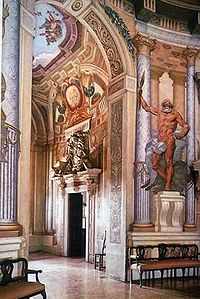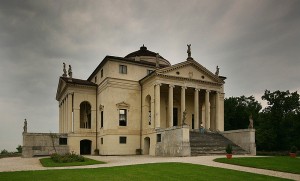#32. Villa Rotunda
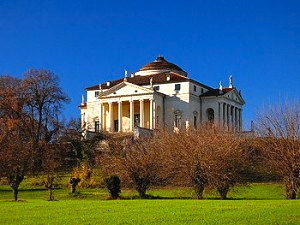
Andrea Palladio – La Rotonda
Universal icon of the Palladian’s Villas, the “Rotonda” is actually regarded by its owner as a town House or, more properly, a suburban House. Infact Paolo Almerico sells his palace in the city to move to outside the walls and the same Palladio, in the Four Books, publishes the “Rotonda” among the Palaces and not between the Villas. Moreover, it’s isolated on top of a small hill and originally there were no outhouses. The canonico Paolo Almerico, for which Palladio designed the Villa in 1566, was a man of shifting fortunes, returned to Vicenza after a brilliant career at the papal court. The House is habitable in 1569, but still incomplete, and in 1591, two years after the death of Almerico, is transferred to the brothers Odorico and Mario Capra who carried it through to completion. Succeeded after 1580 Palladio, Scamozzi substantially completed the project with very limited deviations. Certainly not a Farm-House, the “Rotonda” is rather a Temple-House, an abstraction, a reflection of a higher order and C. Its corners oriented to the four cardinal points, wishes to be read primarily as a volume, cube and sphere, almost recalled the basic Platonic universe.The fact is that the “Rotonda” is unique in the architecture of all times as if, building a villa perfectly corresponding to itself, Palladio had wished to construct an ideal model of architecture.
Coordinates 45°31’55.28″N – 11°33’34.26″E
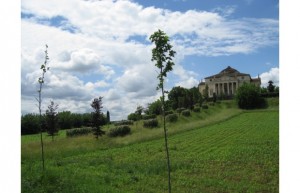 Villa Rotunda Location: Vicenza, Italy Architect: Andrea Palladio Year: 1571
Villa Rotunda Location: Vicenza, Italy Architect: Andrea Palladio Year: 1571
Palladio has been mentioned twice already, so of course one of his own buildings has to be listed. The Villa Rotunda is the crowing achievement of the architect’s theories of proportion, and is the single most important building in establishing his architectural legacy.
Villa Capra “La Rotonda” in Vicenza.
 Villa La Rotonda is a Renaissance villa just outside Vicenza, northern Italy, designed by Andrea Palladio. The proper name isVilla Almerico Capra, but it is also known as La Rotonda, Villa Rotonda, Villa Capra and Villa Almerico. The name “Capra” derives from the Capra brothers, who completed the building after it was ceded to them in 1592. Along with other works by Palladio, the building is conserved as part of the World Heritage Site “City of Vicenza and the Palladian Villas of the Veneto.”
Villa La Rotonda is a Renaissance villa just outside Vicenza, northern Italy, designed by Andrea Palladio. The proper name isVilla Almerico Capra, but it is also known as La Rotonda, Villa Rotonda, Villa Capra and Villa Almerico. The name “Capra” derives from the Capra brothers, who completed the building after it was ceded to them in 1592. Along with other works by Palladio, the building is conserved as part of the World Heritage Site “City of Vicenza and the Palladian Villas of the Veneto.”
Inspiration
In 1565 a priest, Paolo Almerico, on his retirement from the Vatican (as referendario apostolico of Pope Pius IV and afterwards Pius V), decided to return to his home town of Vicenza in the Venetian countryside and build a country house. This house, later known as ‘La Rotonda’, was to be one of Palladio’s best-known legacies to the architectural world. Villa Capra may have inspired a thousand subsequent buildings, but the villa was itself inspired by the Pantheon in Rome.
Design
The site selected was a hilltop just outside the city of Vicenza. Unlike some other Palladian villas, the building was not designed from the start to accommodate a working farm. This sophisticated building was designed for a site which was, in modern terminology, “suburban”. Palladio classed the building as a “palazzo” rather than a villa.
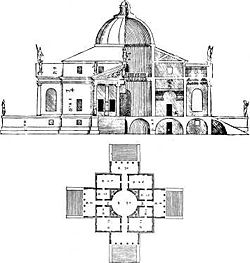 Palladio’s plan of Villa La Rotonda, in I Quattro Libri dell’Architettura 1570.
Palladio’s plan of Villa La Rotonda, in I Quattro Libri dell’Architettura 1570.
The design is for a completely symmetrical building having a square plan with four facades, each of which has a projecting portico. The whole is contained within an imaginary circle which touches each corner of the building and centres of the porticos. (illustration, left). The name La Rotonda refers to the central circular hall with its dome. To describe the villa, as a whole, as a ‘rotonda’ is technically incorrect, as the building is not circular but rather the intersection of a square with a cross. Each portico has steps leading up, and opens via a small cabinet or corridor to the circular domed central hall. This and all other rooms were proportioned with mathematical precision according to Palladio’s own rules of architecture which he published in the Quattro Libri dell’Architettura.
The design reflected the humanist values of Renaissance architecture. In order for each room to have some sun, the design was rotated 45 degrees from each cardinal point of the compass. Each of the four porticos has pediments graced by statues of classical deities. The pediments were each supported by six Ioniccolumns. Each portico was flanked by a single window. All principal rooms were on the second floor or piano nobile.
Building began in 1567. Neither Palladio nor the owner, Paolo Almerico, were to see the completion of the villa. Palladio died in 1580 and a second architect, Vincenzo Scamozzi, was employed by the new owners to oversee the completion. One of the major changes he made to the original plan was to modify the two-storey centre hall.
Palladio had intended it to be covered by a high semi-circular dome but Scamozzi designed a lower dome with an oculus (intended to be open to the sky) inspired by the Pantheon in Rome. The dome was ultimately completed with a cupola.
Interior
The interior design of the Villa was to be as wonderful, if not more so, than the exterior.Alessandro and Giovanni Battista Maganza and Anselmo Canera were commissioned to paint frescoes in the principal salons.
Among the four principal salons on the piano nobile are the West Salon (also called the Holy Room, because of the religious nature of its frescoes and ceiling), and the East Salon, which contains an allegorical life story of the first owner Paolo Almerico, his many admirable qualities portrayed in fresco.
The highlight of the interior is the central, circular hall, surrounded by a balcony and covered by the domed ceiling; it soars the full height of the main house up to the cupola, with walls decorated in trompe l’oeil. Abundant frescoes create an atmosphere that is more reminiscent of a cathedral than the principal salon of a country house.
Landscape
From the porticos wonderful views of the surrounding countryside can be seen; this is no coincidence as the Villa was designed to be in perfect harmony with the landscape. This was in complete contrast to such buildings as Villa Farnese of just 16 years earlier. Thus, while the house appears to be completely symmetrical, it actually has certain deviations, designed to allow each facade to complement the surrounding landscape and topography. Hence there are variations in the facades, in the width of steps, retaining walls, etc. In this way, the symmetry of the architecture allows for the asymmetry of the landscape, and creates a seemingly symmetrical whole. The landscape is a panoramic vision of trees and meadows and woods, with the distant Vicenza on the horizon.
The northwest portico is set onto the hill as the termination of a straight carriage drive from the principal gates. This carriageway is an avenue between the service blocks, built by the Capra brothers who acquired the villa in 1591; they commissioned Vincenzo Scamozzi to complete the villa and construct the range of staff and agricultural buildings. As one approaches the villa from this angle one is deliberately made to feel one is ascending from some less worthy place to a temple on high. This same view in reverse, from the villa, highlights a classical chapel on the edge of Vicenza, thus villa and town are united.
Film
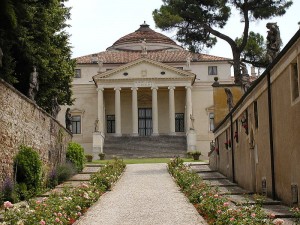 Service corridor leading up to building facade
Service corridor leading up to building facade
In 1979, American film director Joseph Losey filmed Wolfgang Amadeus Mozart‘s opera Don Giovanni, in Villa La Rotonda and the Veneto region of Italy. The film was nominated for several César Awards in 1980 including Best Director, and has generally been praised as one of the finer adaptations of opera to the big screen.
Current conditions
In 1994 UNESCO designated the building as part of a World Heritage Site.
The late owner of the villa was Mario di Valmarana († Oct. 13, 2010), a former professor of architecture at the University of Virginia. It was his declared ambition to preserve Villa Rotonda so that it may be appreciated by future generations. The interior is open to the public on Wednesdays and Saturdays, except during the winter months, and the grounds are open every day.

